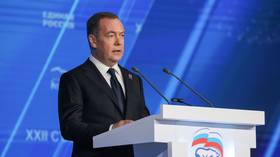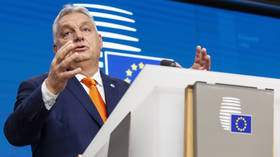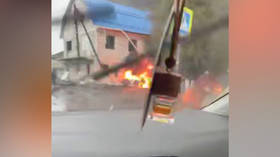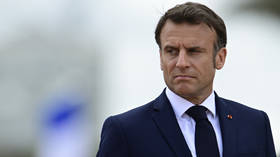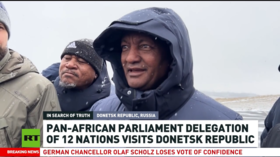Ukraine names Russia as ‘military adversary’ in official defense doctrine

Ukraine's National Security and Defense Council has approved the country’s new military strategy, which defines Russia as a “military adversary”. Ukraine is also officially dropping its non-aligned status, and placing itself on course to join NATO.
The new document, unveiled in a Wednesday statement, “emphasizes the need to improve” the professional skills of the country’s army, and warns of the “high probability” of foreign military involvement in its internal conflict.
The Ukrainian Defense Council also supported the suggestion of the Cabinet and security officials to expand the list of economic sanctions imposed on Russian “legal bodies and individuals”, TASS news agency reported.
READ MORE: UK announces doubling of military training for Ukrainian army – now for 2,000 soldiers
According to the statement, Russian nationals were “involved in financial support of terrorists and other criminal activities, as well as in the violation of the international law, having supported the annexation of the Ukrainian territory by the Russian Federation”.
Ukrainian officials referred to Crimea's decision to join Russia after a local referendum showed overwhelming support for the move last March.
READ MORE: Poroshenko inks permission for foreign troops in Ukraine
Other points of the draft document, which will be handed over to Ukrainian President Poroshenko, define the signs of a military conflict inside the country, consider the increasing role of informational and psychological operations, and point out the necessity of an upgrade of the current system of mobilization and mobilization training.
Commenting on the new doctrine, President Poroshenko said that its novelty is based on a shift of emphasis to a more complex use of military and non-military instruments.
“It fundamentally changes the character of the armed struggle. As a matter of fact, it is what we call hybrid warfare,” he said, as cited by TASS.
Russia was accused of leading a “hybrid war” against Ukraine by Western countries. The concept, introduced in 2000s, stands for a complex military strategy that unites conventional and irregular warfare, such as terrorism, as well as cyber and information warfare.
.@poroshenko on New Military Doctrine:all military threats&challenges are related to #Russia#StopRussianAggressionpic.twitter.com/rlRIGshWEC
— MFA of Ukraine (@MFA_Ukraine) September 2, 2015Poroshenko also noted that a “common thread” of the document is the Euro-Atlantic integration, adding that by year 2020 the Ukrainian military forces would have to be “fully compatible” with the military of the NATO member states, and envisages its “comprehensive membership.”
Kiev has long accused Russia of a “secret war” in the southeast of Ukraine, where local rebel forces fight against the military of the coup-imposed government. Moscow denies the allegations, pointing to the fact that no evidence has been provided to prove the claims.
Meanwhile, this summer the Ukrainian president managed to estimate a new number of Russian troops allegedly fighting on Ukrainian territory, indicating a 22-fold increase in just one month. While on June 4, he stated to Ukraine’s parliament that there were about 9,000 Russian troops, in an interview published at the end of the month the number jumped to a considerably greater figure of 200,000.
In June, President Poroshenko introduced changes to the country's legislation, allowing foreign troops to be stationed in Ukraine, with the possibility of nuclear weapons deployment. Currently, the US, Canada and the UK have provided the Ukrainian troops with dozens of their military trainers and non-weaponized hardware.
In May, Ukraine’s Deputy Economy Development Minister Aleksandr Borovik said in an interview that Russia would have to pay Ukraine $350 billion in damages for the “aggression.” He compared the situation in his country with Iraq’s invasion of Kuwait back in 1991.


